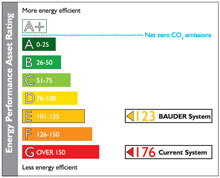Lifting Energy Performance Ratings
LANCHESTER HIGH SCHOOL, DURHAM
The Energy Performance Rating was lifted from 'G' to 'E' through the replacement Bauder waterproofing and integrated insulation saving the school over £24,000 on heating bills a year.
Further imrpovement to the EPC would require greater wall insulation, replacement windows, 100% low energy lighting and improved controls on the heating system.

The red, yellow and green areas on the thermographic images below show the areas of damaged insulation due to water ingress on the failed original roof covering prior to complete refurbishment with a Bauder waterproofing system.

School's Refurbished Roof Lifts Energy Performance Ratings Saving Over £24,000 a Year on Heating Bills.
Upgrading a building to achieve a better Commercial Energy Certificate (CEC), particularly the external envelope where heat loss can be greatest, is a focus for many needing to improve or refurbish a building. One of the most common elements to upgrade is the roof, and with new minimum insulation levels to achieve through the implementation of new Building Regulations, the energy savings can now be quantified.
A recent thermographic survey on Lanchester High School in Durham, showed the exact extent of damage and condition of the failed waterproofing on its 1,800m2 roof. The report showed clearly the areas of bad condition and identified areas where the existing insulation was damaged. By replacing the existing roof covering with Bauder waterproofing system and integrated insulation, the energy rating improved from a G to an E with a saving of 174,600kWh per year, which at current energy costs equates to a saving of £24,500* and a CO2 reduction of approximately 74 tonnes per year.
The survey and calculations showed that additional improvement to the insulation on the roof would not increase the rating any more and that to achieve further improvement in the rating would require greater wall insulation, replacement windows, 100% low energy lighting and improved controls of the heating system.
The thermographic report enabled the school’s building manager to literally see the defects and quantify energy loss. He was then able to make an informed decision on the identified savings and prioritise his budget.
* based on energy prices at time of press release date